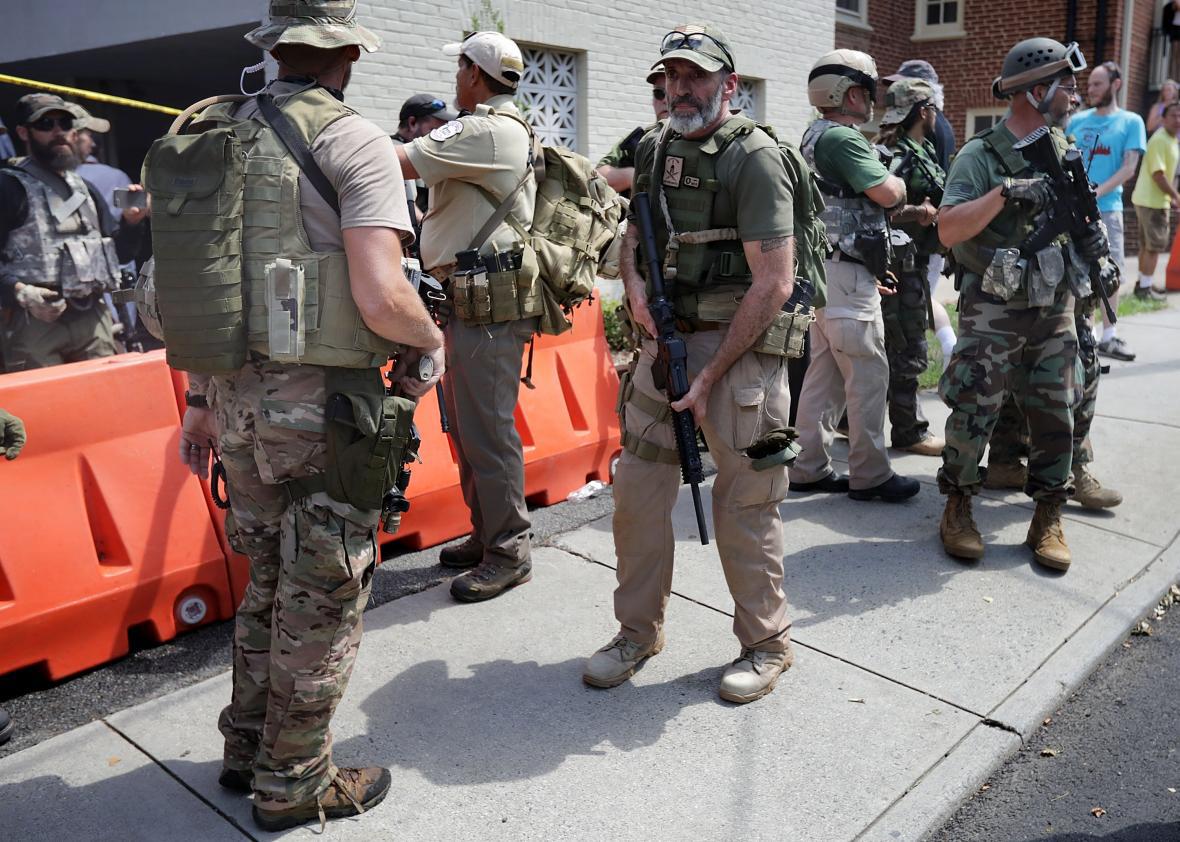With more white nationalist rallies planned in the coming weeks, including one this upcoming Saturday in Boston, cities across the country may soon be looking for ways to try to prevent the sort of violence that took place last weekend in Charlottesville, Virginia.
Boston’s Mayor Martin Walsh is reportedly looking into legal grounds to stop the next alt-right rally from happening in his city. Those rallygoers are permitted, though, and have a First Amendment right to peaceably assemble.
Peaceably is the key word there, however. The white supremacists who showed up in Charlottesville were reportedly armed to the teeth. Virginia Gov. Terry McAuliffe claimed his state police were outgunned on Saturday, while one white nationalist leader showed off his firepower in a popular Vice News documentary about the weekend’s events. Another rallygoer in that video—clad in camouflage—seemed to be warning police that he planned to “send at least 200 people with guns” to gather equipment that was at the site of the rally. Heavily armed paramilitary groups barely distinguishable in appearance from law enforcement officials, meanwhile, made their own show of force in Charlottesville, saying they were there to keep the peace between white nationalist rallygoers and counter-protesters.
As my Slate colleagues Dahlia Lithwick and Mark Joseph Stern reported on Monday, those trying to exercise First Amendment rights clashed with those claiming to exercise Second Amendment rights—including Virginia’s open-carry laws—in Charlottesville, and the guns won. Current constitutional doctrine, they argued, is poorly equipped to handle a situation where one heavily armed group of assemblers is able to silence with their weaponry the free speech rights of a different group of would-be assemblers.
But University of Virginia professor Philip Zelikow argues that the Constitution does allow for restricting armed rallies. Writing in Lawfare, Zelikow notes that there is precedent for preventing groups of heavily armed white supremacists from gathering in intimidating mass assemblies:
In 1981 an organization called the Knights of the Ku Klux Klan organized and trained paramilitary groups to harass Vietnamese-American fishermen on the Texas Gulf coast. They, too, wore Army-surplus-style clothes and gear, not white sheets. Working with Morris Dees and the Southern Poverty Law Center, David Berg and I represented the fishermen in a federal lawsuit against the Klan. We invoked a Texas law more than a century old that banned “military companies” other than those authorized by the governor. There are similar laws in most states, including Virginia.
We asked the judge to shut down the Klan’s paramilitary activities. Since this law had never been interpreted, we developed a legal standard to define the barred activity—a guideline that would distinguish scouts, hunters and Civil Air Patrol cadets from heavily armed men with assault weapons practicing for violent confrontations. We focused on private efforts to create a military or paramilitary organization that had “command structure, training and discipline so as to function as a combat or combat support unit.”
The judge granted their request, the order worked, and the group was enjoined from displays of intimidation.
Reading a description of one white supremacist group in Charlottesville by BuzzFeed News reporter Blake Montgomery, it’s hard not to think of that standard for an illegal paramilitary gathering:
Most white supremacist and Nazi groups arrived armed like a paramilitary force — carrying shields, protective gear, rods, and yes, lots of guns, utilizing Virginia’s loose firearm laws. They used militarized defensive maneuvers, shouting commands at one another to “move forward” or “retreat,” and would form a line of shields or a phalanx — it’s like they watched 300 a few times — to gain ground or shepherd someone through projectiles.
In his article, Zelikow went onto write that, while the Second Amendment guarantees a right to a “well-regulated militia,” federal courts have held that private militias do not have the right to free reign.
“When private self-styled militias get organized, equipped to fight, and travel to my town for a confrontation, this is not a Second Amendment story,” Zelikow told me over email. “They are organized to violate civil rights and intimidate my townspeople, to show their strength not with their speech, but with their firepower.”
Zelikow argues that towns and citizens have the right to sue and enjoin such heavily armed organized groups from staging such rallies. He also suggests that rallygoers like the ones in Charlottesville—as well as some of the counter-protesters—might have fit the standard for such an injunction. “[T]here were a number of clusters that deployed together with standardized dress (to recognize each other), standardized insignia, similar combat/riot gear, and similar classes of weapons,” Zelikow, who worked in multiple prior presidential administrations, said over email. “Not incidentally, the Antifa [anti-fascist] group also has some standardized identifiers (red neckerchiefs, for example), deploys together in an obviously coordinated way, and carried assault weapons.”
(At least one leftist group was reported to have showed up armed with guns.)
Ultimately, Zelikow compares the appearance of these sorts of heavily armed groups asserting the right to mass public assembly to darker periods in world and U.S. history:
This is not a recipe for free speech, even heated speech. These are the ingredients for civil violence. Historians will find it all too reminiscent of the setups for the pitched street battles in late-stage Weimar Germany, except that then the two sides were not nearly so well armed.
My point is that American law and the civil power in America is not now, and never has been, helpless in the face of such preparations for organized civil violence. Some of the more shameful episodes in our earlier history, such as race massacres, labor violence, and anti-religious riots (for instance against the Mormons) arose when the civil power stood by in such situations.
The coming weeks seem likely to continue to test that line between protected assembly and unprotected civil violence. The ability of civil authorities to respond when that line is crossed also seems likely to face some very serious challenges.
